Living with two dogs who don’t get along is an unfortunately common problem. We get comments, emails, and messages about this very issue all the time here at K9 of Mine.
In fact, my wife Michelle and I actually experience this every day – our girls do not like each other.
But we’ve learned to manage this problem pretty well. So, I figured I’d share some of the things – 12 in total — that we’ve found helpful for managing two dogs who fight.
I’m going to explain a bit about our girls and living situation first, and then we’re going to talk a bit about the differences between training strategies and management approaches.
Then, I’ll move on to the actual tips (feel free to skip down to the list if you like).
Our Pooches: Two Dogs Who Do NOT Get Along
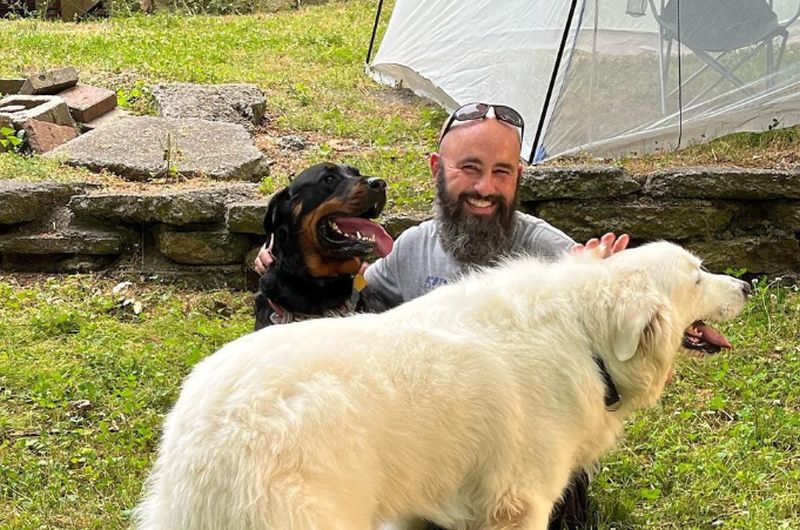
If memory serves, Michelle and I were already sharing selfies with our dogs by our fourth or fifth text.
To be fair, my dog is easier on the eyes than I am, so it was just good strategy on my part. At any rate, it worked, and we hit it off.
But trouble lurked in the tall grass ahead.
The dogs are both clearly “ours” at this point, but I brought a 7-year-old Rottie to the relationship, while she brought a great Pyrenees of the same age.
They’re both super sweet with people they know, but both gals are a bit reactive around strangers and other dogs.
We tried to do everything “right” when introducing them.
This included parallel walks (see a demo of what that looks like below), off-leash greetings on neutral turf, and doling out lots of high-value treats when they were in each other’s presence (a technique called desensitization and counter-conditioning, which is designed to replace negative associations with positive ones).
We did it all.
But none of it worked.
They’d fight violently whenever they had the chance (save for the one exception from the photo above — and even that session ended with a fight).
The Rottie was (and remains) the primary instigator, but the Pyr certainly doesn’t back down.
And these fights are horrifying to behold.
These are big, imposing gals, and both have suffered injuries while clashing (as have I, while trying to separate them).
The combatants girls, for your viewing pleasure:
J.B. (Rottweiler)
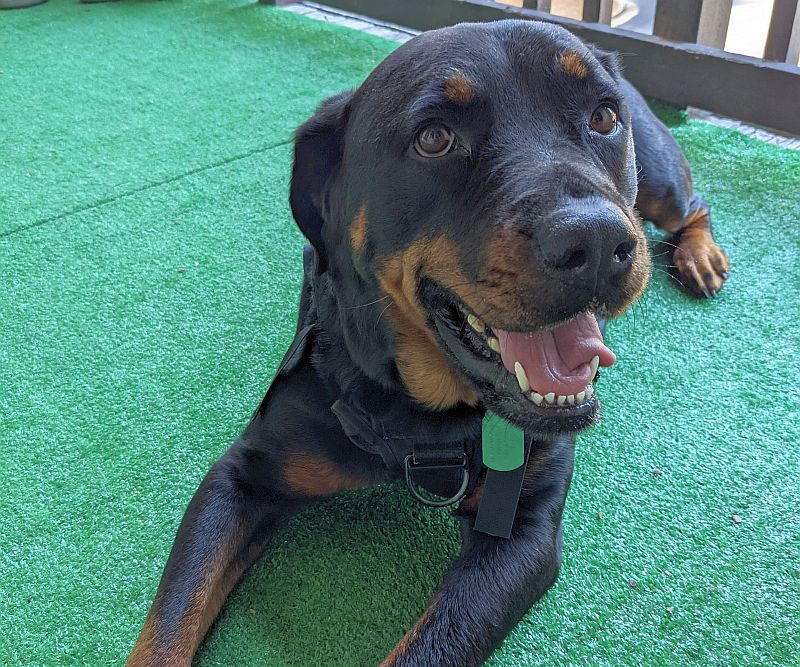
- Sex: Female
- Aliases: Jabbs, Protocol Patrol, The Brute Squad
- Weight: 88 pounds
- Favorite Food: Chicken, asparagus, bell peppers, cheese
- Hobbies: Full-contact MMA with dad, sleeping by mom’s feet, farting, and monitoring everything to make sure everyone is behaving in accordance with established protocols
- Special Skills: Demanding attention, antagonizing her sister
Willow (Great Pyrenees)
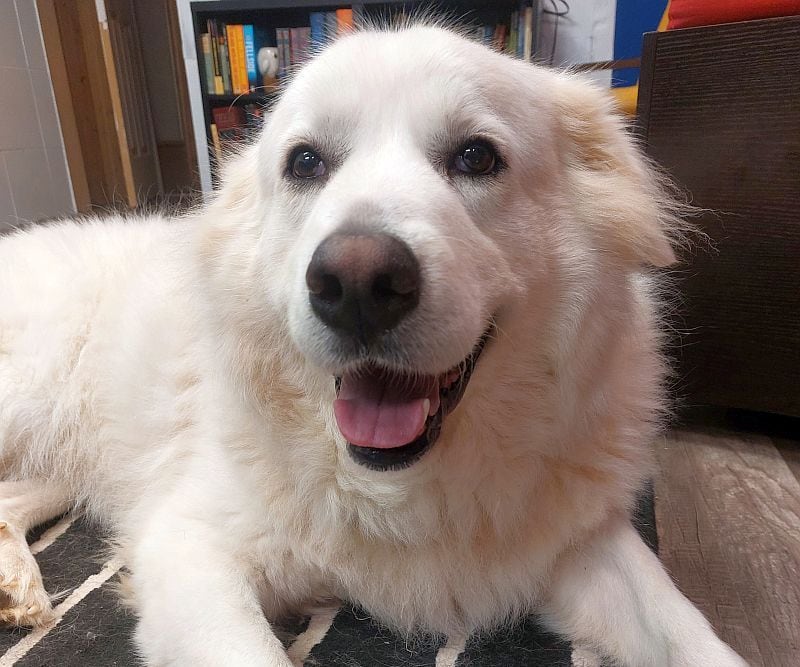
- Sex: Female
- Aliases: Wi (pronounced “Weee”), Weewoah, Crazy Pants
- Weight: 90 pounds (+/- 2 pounds of outdoor detritus caught in her fur)
- Favorite Food: Pizza bones (crusts)
- Hobbies: Borking at things, borking in all directions at nothing in particular, eating acorns, covering her coat in Georgia red clay, and punching mom or dad with the “Pyr paw” in pursuit of pets (IYKYK)
- Special Skills: Polar bear impersonations, wheelies
After trying to get the girls to get along for a few months, we eventually just threw in the towel and realized they weren’t going to be friends.
Hell, they weren’t even going to be neutral neighbors.
I still remember feeling utterly defeated as I drove to the pet store to pick up two heavy-duty dog crates so they could sleep safely in the same room.
Plus, I was beside myself with worry.
I worried about their quality of life.
I worried about their safety.
I worried about our sanity.
But all of these months later, things have worked out pretty well.
We just had to change our approach.
Training vs Management: Two Different Approaches to Dog Care
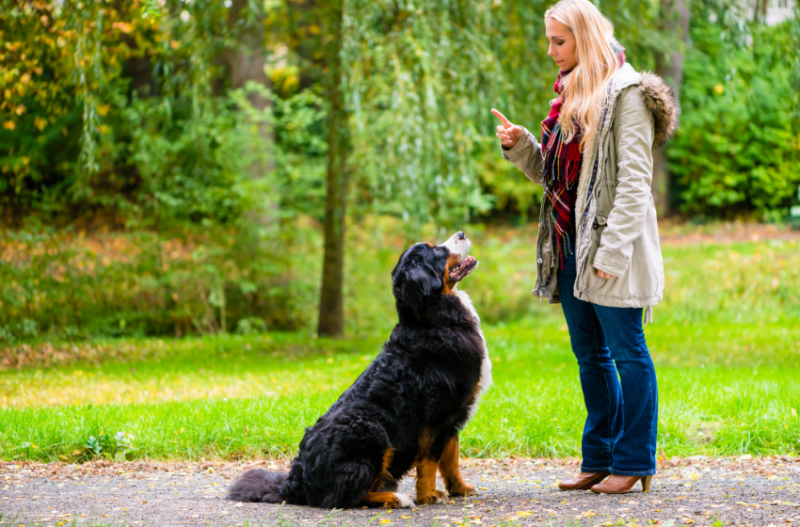
You can approach dog behavioral issues in one of two basic ways: You can try to alter your dog’s behavior, or you can just manage the situation in a way that eliminates or reduces the issue.
Have a dog who pulls on the leash?
You could try to train your dog to stop pulling on the leash or you could just use a no-pull collar or harness.
Have a dog who won’t stop peeing in the house?
You could revisit housetraining, or you could simply throw down some pee pads in a puppy pen and call it a day.
Have a dog who barks out the window all day?
You could try to teach her a “quiet” command or you could just install some dog-proof blinds so she can’t see triggering things out the window.
See the difference?
Typically, dog owners use a combination of techniques and strategies from both sides of the spectrum.
You may teach your dog a “quiet” command, but still limit the amount of time she’s allowed to look out the window at squirrels. Or you may work on housetraining while also laying down some pee pads in a pupper pen until she gets the hang of things.
But in our case, we cranked the dial all the way to the management side.
These gals weren’t going to get along, so we simply had to implement protocols that prevented them from hurting each other (or driving us crazy).
In a perfect world, behavioral modification is probably the ideal approach when dealing with cohabitating canines who don’t get along.
But that’s just not always realistic or feasible.
So, as we are fond of saying, you have to do what’s right for you and your dogs. We all just have to figure this pet-parent thing out the best we can.
12 Tips for Living with Dogs Who Don’t Get Along
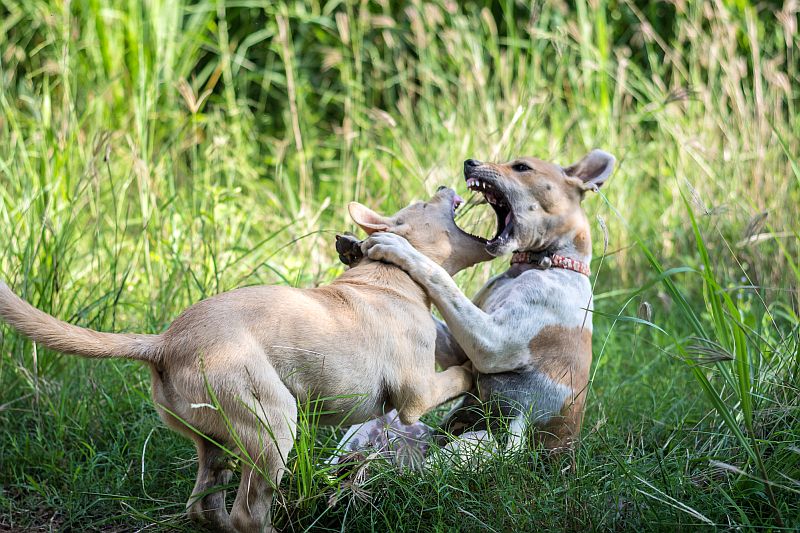
Now that you understand the difference between management approaches and behavioral modification (and have likely decided the former is the better choice than the latter for your situation), we can share some of the things that have proven helpful for Michelle, me, and our pups.
Fair warning: There’s nary a magic bullet to be found among them. It’s still going to be tough.
But what can you do besides try?
So, I encourage you to consider these tips, embrace the ones that seem useful, ignore the ones that don’t apply, and tweak anything you want to suit your specific circumstances.
1. Use Doggie Gates Liberally
There’s no room for debate here: Dog gates are critical for managing two large dogs who don’t get along in the same home.
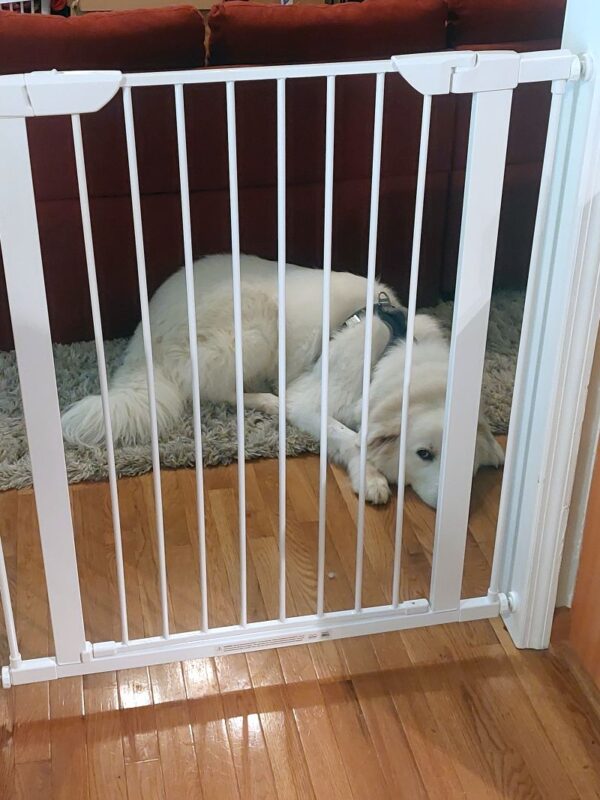
I don’t know how we’d manage the girls and give them a high-quality of life without the one we have. In fact, we’re adding at least one more in the next few days.
We have placed ours between the living room and the kitchen.
Michelle and I try to hang out on different sides of the gate a fair bit so both of the girls have company.
For example, I cook a bunch, and Michelle will chill at the breakfast bar and game while I do. One of the pups is with me and the other with her.
We try to mix up the girls the best we can, but sometimes one just works in one place better than the other.
Now, doggie gates are annoying as hell. Having to open and close a gate 50 times a day sucks. But it’s still a net positive in the battle to manage two dogs who fight.
Just be sure that the gates are strong enough to withstand a full-blown throw down. I originally thought it would be strong enough without the mounting hardware, but the girls managed to partially dislodge it, so I busted out the drill and fixed the issue.
2. Use Double Barriers When Feasible

This is a concept that is common to many types of animal care – especially in situations involving animals who are dangerous. It’s occasionally called instituting a “double bubble” among canine behaviorists.
It simply means keeping two barriers between dogs who don’t get along, rather than only one.
For example, you may place one dog in your bedroom.
But instead of placing your other dog in the hallway outside the bedroom door, you confine her to another bedroom.
You now have two barriers between each animal, rather than one. You also have an entire empty room (the hallway) between them.
This way, if something goes wrong – such as someone accidentally opening the wrong door or a pooch squirting out unexpectedly – you have a backup barrier in place to prevent a fight.
Now, honestly speaking, Michelle and I do not maintain a double barrier at all times. There are plenty of times in which the dogs are only separated by a single barrier – often a dog gate.
But we try to limit this to times in which we’re close by and paying attention to them. When we go to sleep for the night or are distracted, we’ll put an extra barrier between them, just for the additional safety it provides.
3. Text with the Other Humans in Your Home Constantly

Communication is key when managing two dogs who don’t get along. I’ll frequently text Michelle to find out who is where.
Where’s J.B.?
Is Willow with you?
Which girl did we leave in the bedroom?
This is pretty easy to do, but you have to keep your head in the game — you can’t get lazy and forget to check in with the other people in your home.
I have been a slacker a few times and opened the door while accompanied by one canine, only to find ourselves staring the other one in the eye (which is yet another reason to try to incorporate double barriers, as mentioned earlier).
That never goes well.
Note that I say “text,” but it doesn’t specifically have to be texts. You just have to check in in some way to make sure that you know what you’re getting into and what’s lurking on the other side of a closed door.
4. Feed Your Dogs in Widely Separated Areas
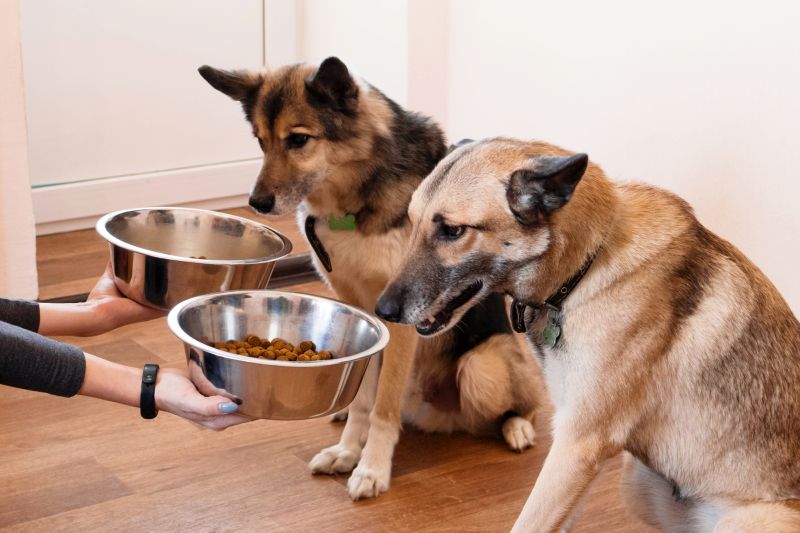
Some dogs will happily eat next to their brothers and sisters, but other dogs are touchy about their food — something called resource guarding. And these dogs may fight savagely whenever food is around.
Willow is probably the less problematic of our two dogs, but she does have some resource guarding issues. She’s always extra alert and reactive around mealtimes.
But we’ve found that we can keep the overall stress level pretty low by simply feeding them in widely separated locations.
Funnily enough, I screwed this up recently.
The gals had been extra irritated with each other all morning, and I just couldn’t figure out why. But being smarter than I am, Michelle came upstairs and pointed at the bag of dog food I’d absentmindedly stored by the gate between them.
Sigh.
It’s a wonder I can dress myself in the morning.
Once I moved it, they both chilled out quite a bit and domestic harmony was restored.
5. Incorporate a “Cooling Off Period” When Returning Home with One of the Dogs

Because our girls don’t get along, I have to walk them or take them to one of their favorite Atlanta-area dog parks separately.
We’ve found that our ladies are most likely to flip out and engage in “gate fighting” when one returns from a walk or outing.
Whoever didn’t get to go on the outing will be waiting right at the gate, clocking the other with what behaviorists call a “hard stare.” The moment we unclip the leashed pooch, the doggos will both fly toward the gate, flipping out and generally causing chaos.
So, we try to preemptively diffuse these situations by keeping them separated for a brief while after returning. We generally do so by having one or both of the girls go lay down in a place that’s away from the gate. Usually, 30 minutes or so is plenty, but your dogs may require more or less time than this.
For example, we may have one lay on the couch while having the other one “help” with dinner.
Then, a half hour or so later, we can let them move around naturally. They’re generally calmer at this point and less likely to have a showdown at the dog-gate corral.
All owners should pick up the basics of canine body language, but it is especially important that owners with multiple dogs learn how to interpret the clues your dog provides.
6. Use and Install Lots of Visual Barriers
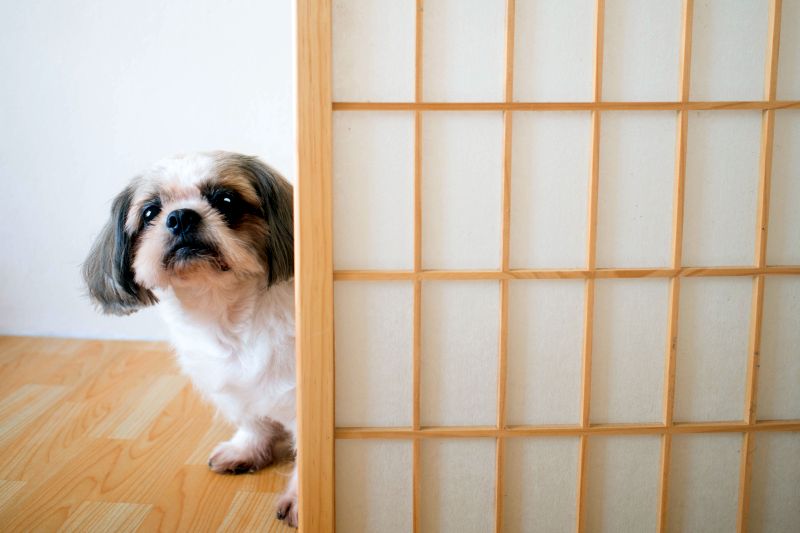
Again, in a perfect world, you’ll keep your dogs separated by a double bubble most of the time. But that’s not always feasible or even possible.
In these times in which your dogs are only separated by a single barrier (like a gate), it can be helpful to install visual barriers. Dogs typically don’t get as upset about other dogs they dislike when they can’t see them.
That’s what we do when letting the gals hang out on opposite sides of the gate for long periods.
We’ve yet to figure out the perfect cover for the gate. Blankets, sheets, or towels are our go-to choices, but these look horrible and they’re a bit of a trip hazard.
For that matter, we’ve seen J.B. deliberately pull the fabric down so she can scream at her sister.
I’d like to figure out some kind of semi-rigid-PVC-sheet-and-Velcro situation, but there are only so many hours in the day. At any rate, towels work for the time being.
At other times, we’ll just keep them on opposite sides of a closed door or play with one in a portion of the backyard that doesn’t have a direct line of sight from the back door.
We’ll even pile couch cushions up pillow-fort-style at one end of the sofa if we’re snuggling with one dog. The other doggo is rarely happy about this arrangement, but simply preventing her from seeing us cuddle with her canine sister helps keep the chaos at a manageable level.
7. Split Up the Sleeping Schedule
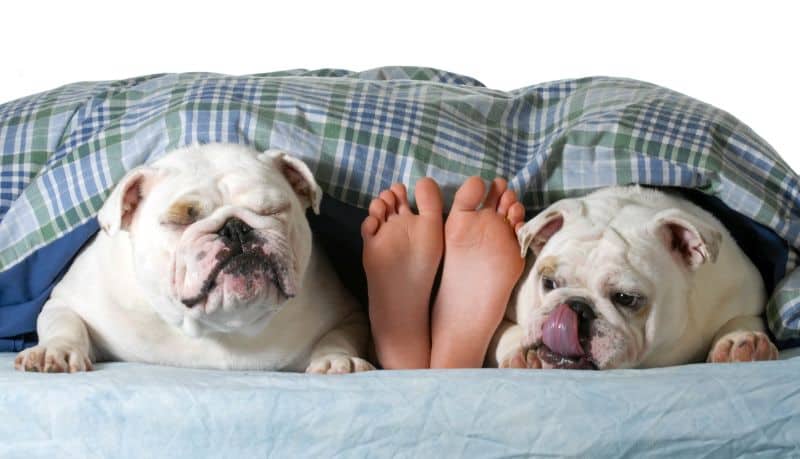
Both of our girls were used to sleeping with their respective person, but this obviously won’t work anymore.
For a while, we just crated them both in the room with us, but that was hardly ideal. They’d still flip out at each other several times a night, and the morning procedure was tricky at best.
So, we’ve simply adopted an every-other-night schedule. One night, J.B. sleeps with us in the bed; the next night is Willow’s turn.
Both girls have adjusted pretty well to this – J.B. loves sleeping on the couch when it’s not her turn with ma and pa, while Willow prefers sleeping with one of Michelle’s kiddos.
We also try to give the girl who’s not sleeping with us that night a wee bit more attention during the afternoon.
It still makes us a little sad to go say goodnight to whomever isn’t going into the bedroom with us, but it’s just one of those things we must do to make things work.
8. Use Crates to Address Temporary Challenges
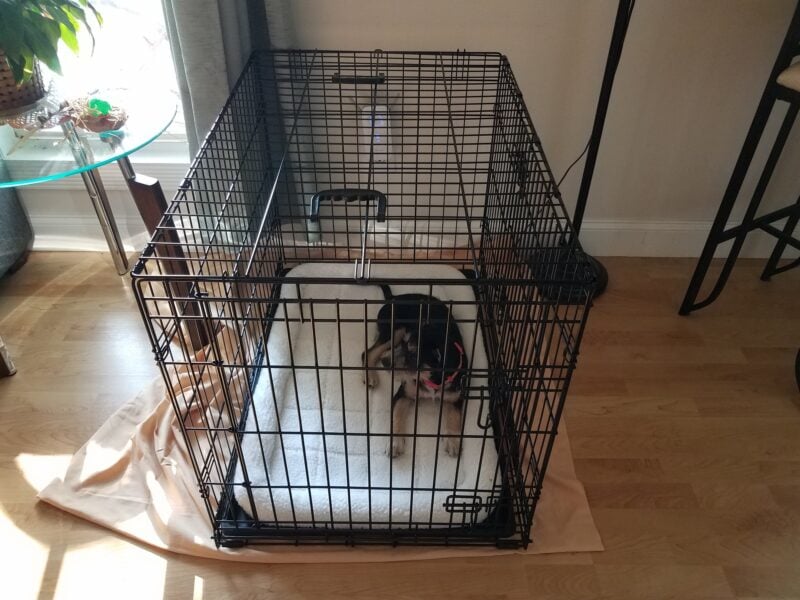
We don’t have to crate either of the girls for housetraining issues or because of destructive tendencies (Willow has a bit of separation anxiety, but she rarely does anything worse than dumping a trashcan).
They’re pretty good little ladies.
But we absolutely love having crates at the ready. Crates are amazing tools for getting through unexpected problems or circumstances that arise.
For example, when guests visit, we may have to put both girls up. And because there are only so many rooms available, we may be forced to put them in the same room.
But crates allow us to put them in the same room for a brief time.
It’s just nice that we always have a place we can temporarily store either of the dogs, while knowing that they are completely safe and pretty darn comfortable.
9. Be Ready to Use Multiple Vehicles
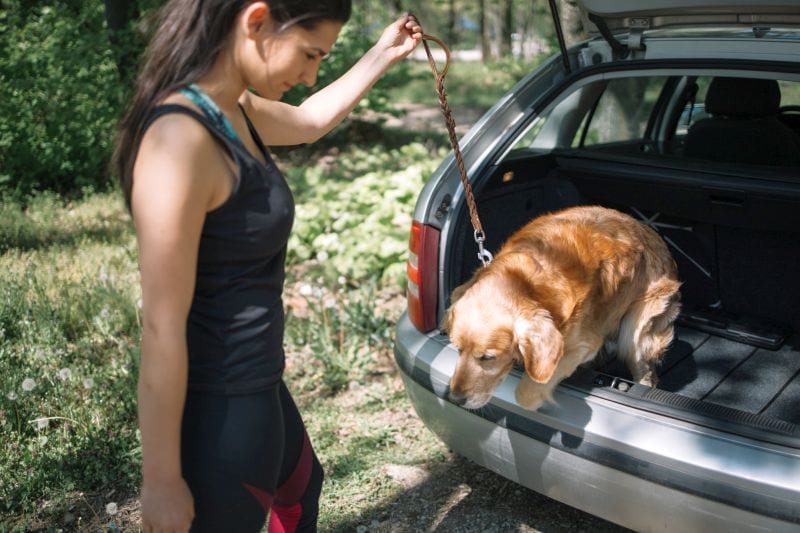
One thing you may not think about when trying to live with two dogs who don’t get along is transportation. Your pups aren’t going to set aside their differences for a car ride – in fact, the close quarters will likely exacerbate any underlying tension.
Crates will work for small dogs, but fitting two large dog crates in a car is a pretty tall task. Michelle and I both drive small to medium-sized SUVs, and it’s difficult to fit a single crate inside either one – never mind cramming in two.
So, you may just need two dog-friendly vehicles.
We tend to just bring one gal or the other when running errands so we can all ride in the same car, but when we have to take both girls with us, we simply have to take two vehicles.
Now, I’m not saying it is easy or advisable to add an additional car to your fleet simply because you have two dogs who don’t get along well. But it may be the only way to reasonably take both of your dogs on the road at the same time.
And there’s one other thing to think about: emergencies.
If you only have one vehicle, you may find yourself in a sticky situation if you’re forced to flee your home in a hurry. But with two cars, you’ll be able to get away from floods, incoming snowstorms, or poltergeists by splitting your dogs into multiple cars.
10. Pick Up a Couple of Multi-Function Leashes
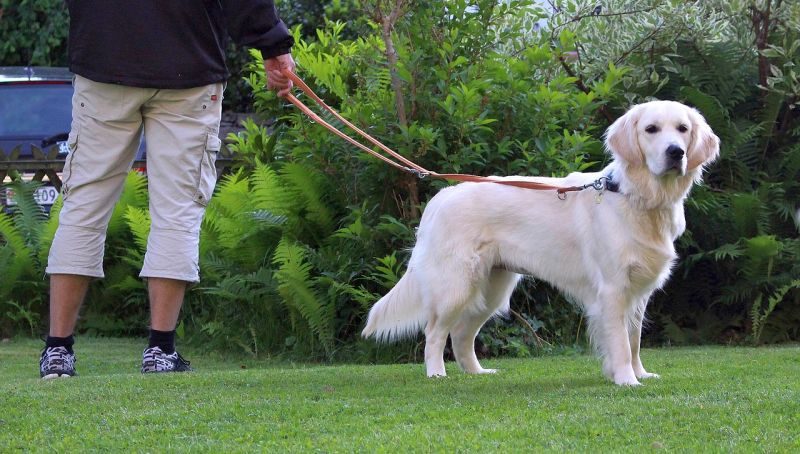
I’ve always been a HUGE fan of multi-function leashes (sometimes called 6-in-1 leashes) for general dog care. But I’ve found them even handier now that I must manage two antagonistic pups.
For the unfamiliar, multi-function leashes are typically about 8 feet long and feature clips at each end. Then, along the length of the leash, you’ll find three or more rings. By fastening the clips to various rings, you can create several different “types” of leash.
You can set them up like standard 6-foot-long leashes, but you can also use them as a double-ended leash you clip to the front and back ring on your pet’s harness. You can also set them up like a hands-free leash (either over-the-shoulder or around-the-waist).
But I love using them as tethers.
Need to attach a dog to the porch railing? Need to keep a dog from running back inside an open door? Need to stop and tie your shoe while on a walk with your woofer?
Just clipity-clip-clip-clip and Bob’s your uncle.
At this point, I honestly feel weird when not using a multi-function leash. I doubt I’d ever buy any other kind of leash again.
11. Install Trolleys or Tie-Outs in Your Yard
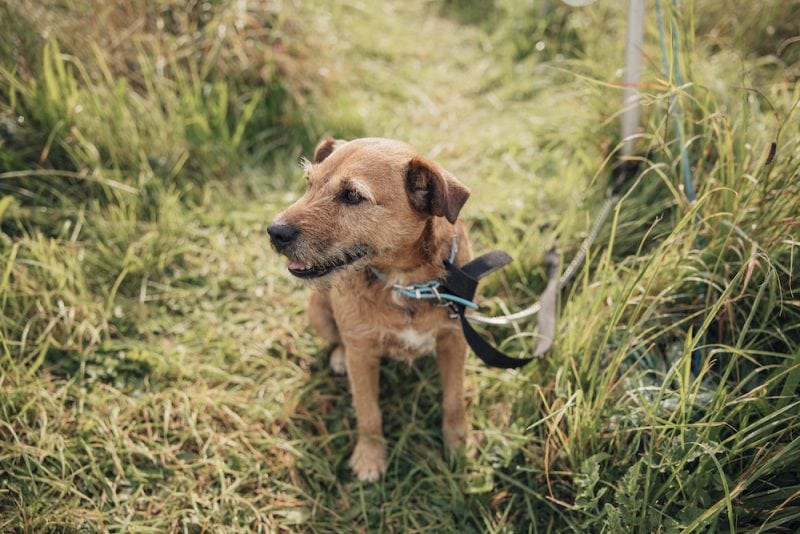
We’re fortunate enough to have a fenced backyard. We all love it, and it has provided one more “dog management zone” we can use to keep the girls happy and safe.
But while this is great during work hours (one girl chills with us while the other enjoys the backyard), it causes some issues during nights spent around the grill or weekends when I’m doing yard work.
One of the girls gets to enjoy the great outdoors, but the other must stay inside.
But there is a solution: We installed two dog trolley lines (essentially, long fixed wires that connect to a freely moving leash tether).
Now, both gals can hang outside with the fam or watch me mow the lawn drink lots of beer while staring at my mower.
You could also use simple tie-outs, which utilize fixed anchors instead of a trolley system. However, trolley lines give your dog much more room to roam.
Each or our trolley lines is about 100 feet long and has a 6-foot-lead, which essentially provides each doggo about 1200 square feet of useable space. We’ve placed the trolley lines about 25 feet from each other, so the girls to hang out safely and enjoy the backyard at the same time.
12. Provide Your Dogs with Tons of Exercise
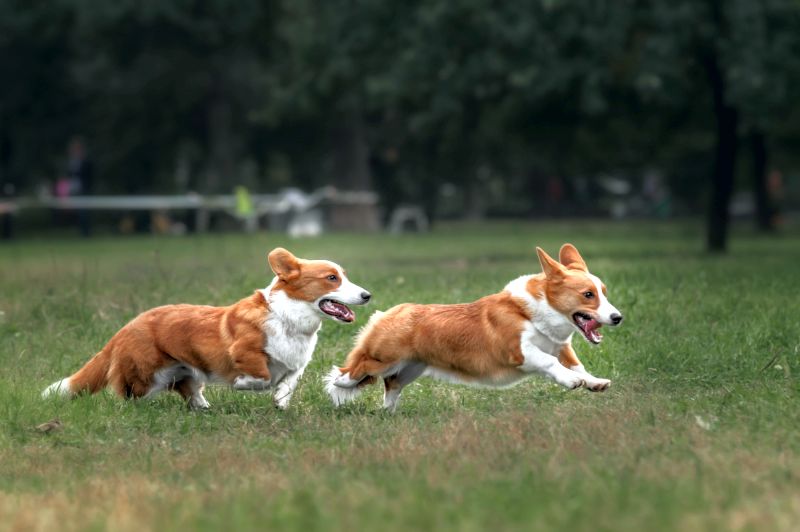
I almost feel bad including exercise as a tip; we recommend it as a management strategy for addressing just about every canine behavior problem there is.
But there’s a reason for that: It. Works. Wonders.
To paraphrase the old saying: “A tired dog is a well-behaved dog.”
And this holds true for reactive doggos living with another dog they hate.
Don’t get me wrong, a couple of games of fetch aren’t going to magically transform your fighting Frenchies into friends. But lots of canine exercise will most likely ratchet the intensity down quite a bit.
Mental enrichment is huge too — regularly adding frozen dog toys, lickimats, interactive dog toys, and puzzle toys to your dog’s daily routine will go a long way to helping your pups chill out (especially for those smarty pants working breeds who need to be performing a job to feel good).
Tiring your pooch out physically and mentally is a great management technique for most dogs, in a variety of scenarios in which your dog is having behavior problems.
At this very moment, our Rottie is sprawled out on the floor between us, having just chased the ball in the backyard a few times. Meanwhile, our Pyr is in the backyard screaming at the squirrels for existing.
Were the Rottie not in post-exercise recovery mode, she’d probably be pretty upset about her sister’s repeated vocalizations. But as-is, she doesn’t care.
And the same would be true in reverse.
So, no matter which management tips or tricks you try, consider including a bit more exercise and mental enrichment as part of your daily gameplan. It’s certainly not easy to do so with two dogs who don’t get along, but it is possible.
It’s always a good idea to keep several food and water dishes — think four or five per dog – on hand.
This doesn’t specifically relate to managing two dogs who don’t get along, but it’s just good advice I wanted to share with those who have multiple pets.
Honestly, I think every dog owner should have multiple sets of food and water dishes – even if you only have one pupper. The convenience it provides is simply amazing.
If you only have one food dish and one water bowl, you’re going to have to stop what you’re doing, wash out the dishes, fill them, and give them back to your pet multiple times each day.
That gets old quickly.
In fact, it often leads to our beloved pets eating and drinking out of dirty dishes.
But if you have a dishwasher and a ton of food and water dishes, it is easy to keep things clean and hygienic.
I am constantly picking up bowls, tossing them in the dishwasher, and rotating them back to the shelf where we keep them. It’s time to feed or water one of them, I just grab a clean bowl from the shelf and go.
[image_full url=”” alt=”” caption=””]
Living with two dogs who don’t get along – particularly when they’re both big pups – is trying. In fact, many owners probably opt to rehome one of the dogs when faced with a dogs fighting situation.
But if you’re like Michelle and me, that just isn’t a consideration – dogs are full-fledged family members.
So, you will just have to make things work one way or another.
Hopefully, some of the tools and tips shared above will help you the way they’ve helped us. But we’d love to hear about some of the things you’ve done to make life easier with two dogs who hate each other.
Let us know in the comments below!
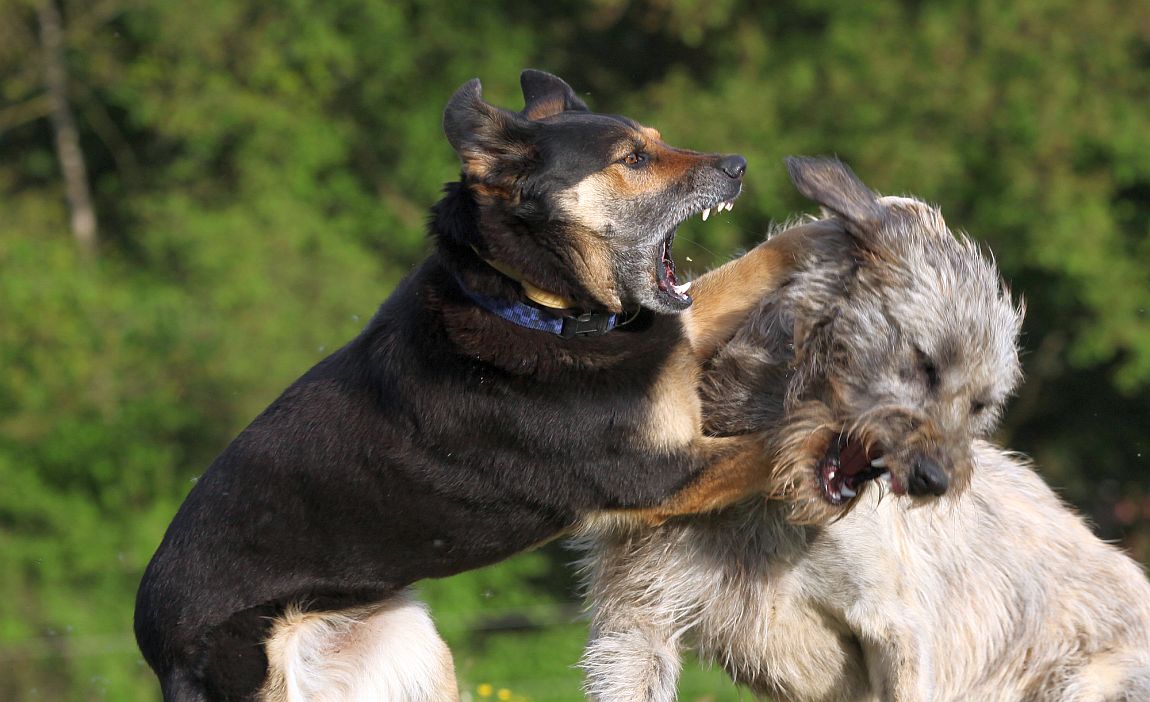

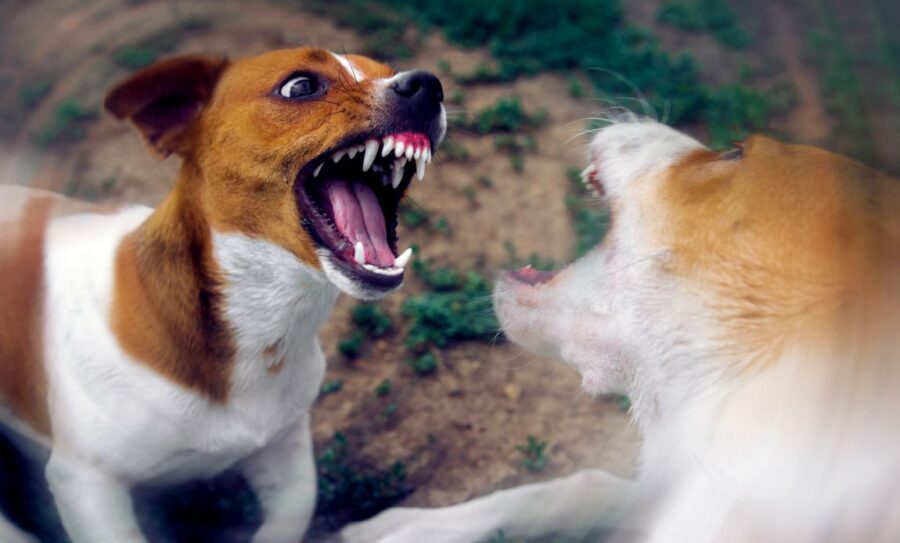


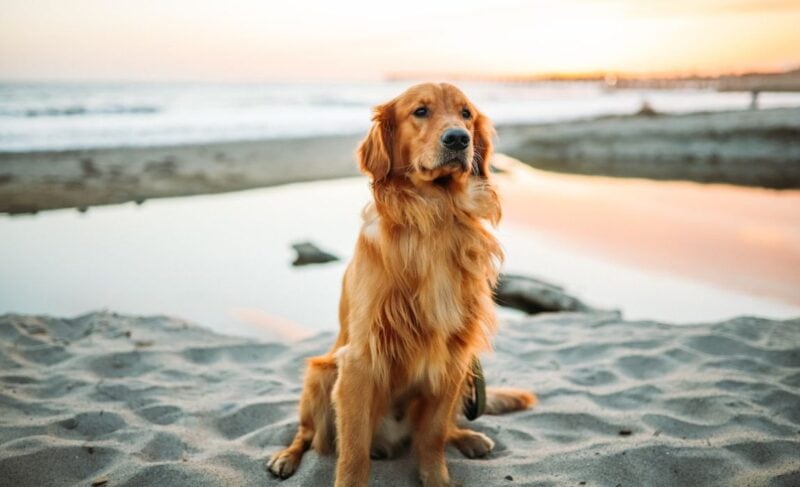

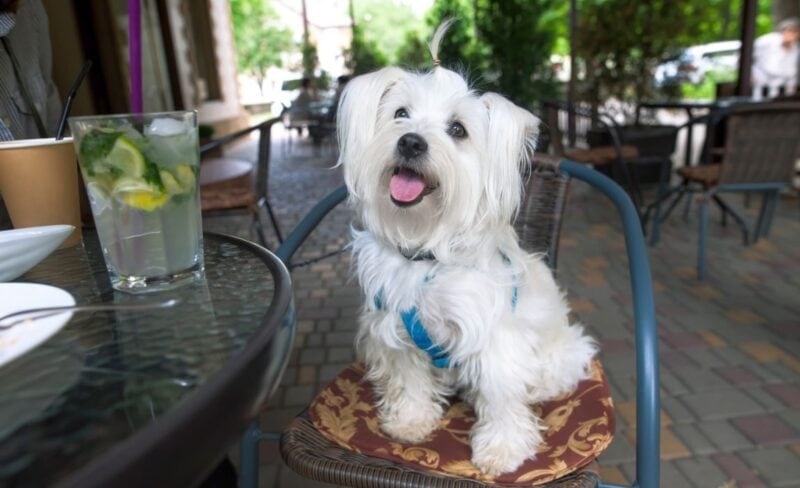
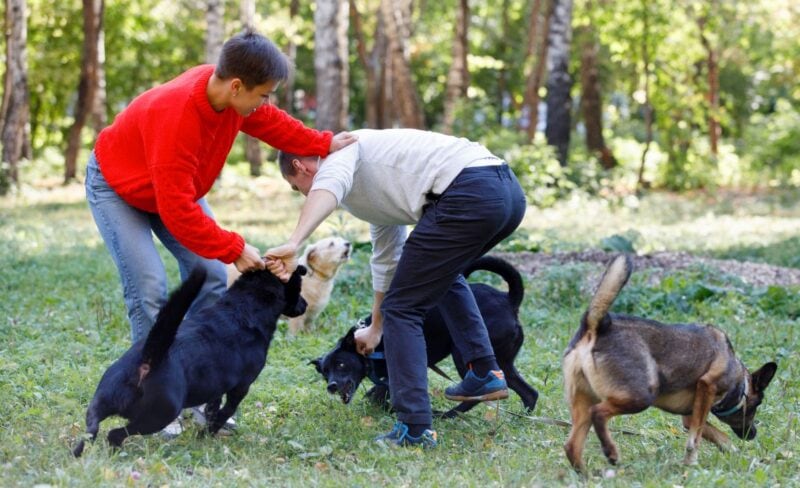

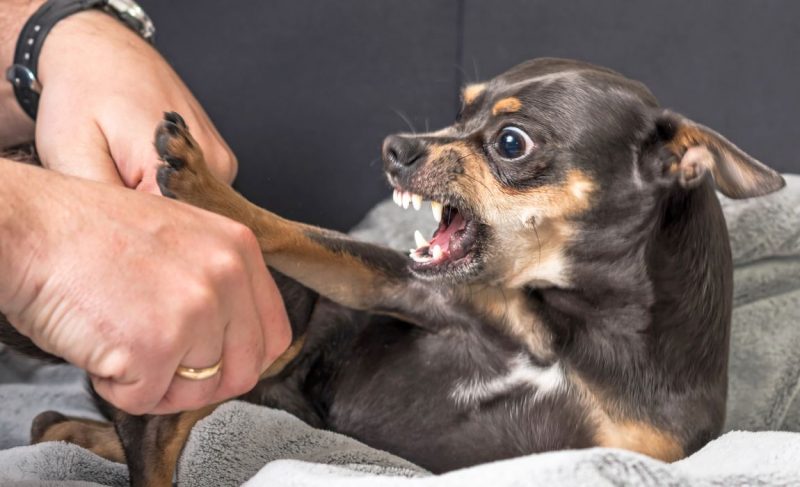
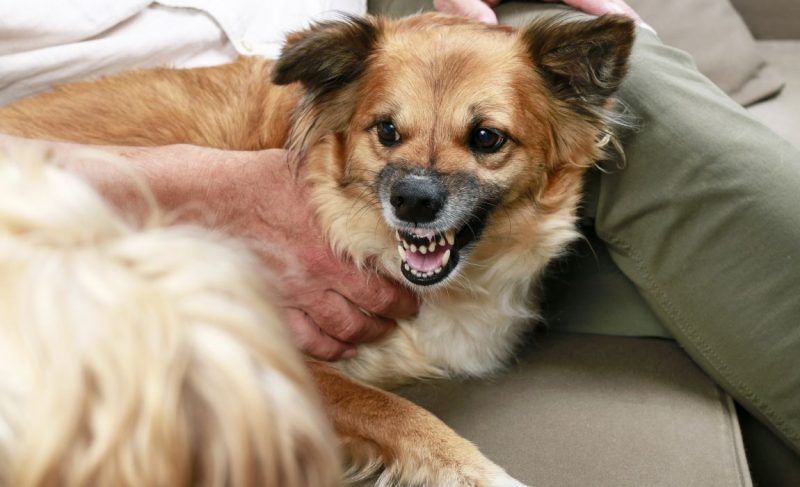

Leave a Comment